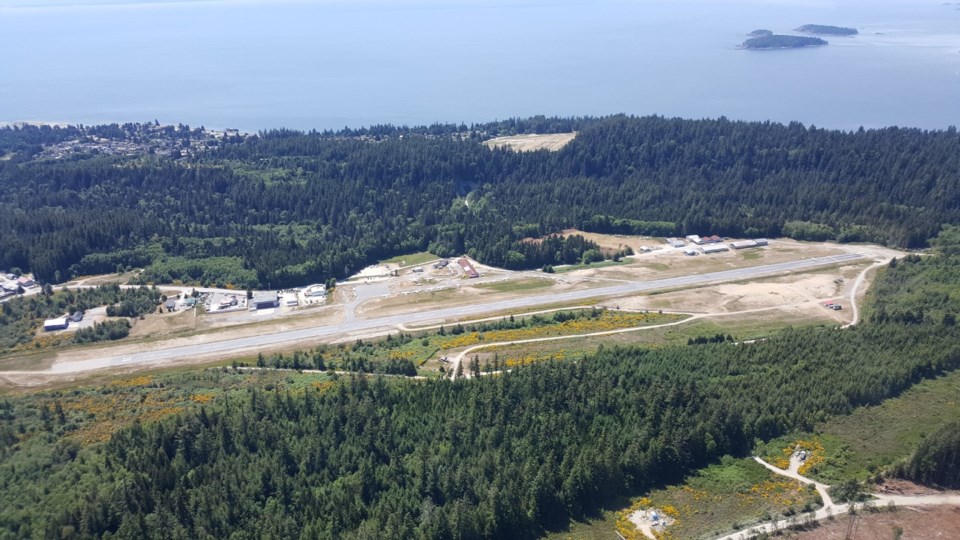Developing luxury tour packages, creating “flight-seeing tours,” and improving customer experiences – possibly by working with shíshálh Nation to include artistic, cultural or educational components – are just a few of the ideas suggested to help revitalize Sechelt Airport, which are included in the final report for the Sechelt Airport Master Plan.
As well, the 62-page report, which was presented to District of Sechelt council at a regular meeting, May 21, notes that for years there has been a significant amount of interest in developing passenger services between Sechelt and the Lower Mainland. To that end, the district has been exploring ways to develop this opportunity, including a runway expansion completed in 2021. (The Sechelt Airport is technically a registered aerodrome, but as with most aerodromes, it is commonly referred to as an airport.)
Earning an airport certification is included in the recommendations listed in the plan, which was written and compiled by consulting firms Operations Economics Inc. with Tetra Tech.
Airport certification
Communities often choose to certify airports because obtaining scheduled passenger services offer significant socio-economic benefits to communities through “improved quality of life and economic impact,” according to the plan. “A small air service can easily provide millions of dollars in direct economic benefit and catalytic impacts. Direct economic impacts refer to benefits created by directly related employment and activity. Catalytic impacts are the most sought after, those such as increased tourism and economic growth resulting from air services enabling other opportunities. While the cost of certification is high, the benefits can be much higher.”
The airport is located in ts'uḵw'um (Wilson Creek), southeast of downtown Sechelt on Hilltop Road at the northern end of Field Road, and is the regional airport for the Sunshine Coast. Centrally located, the airport is about 27 km from the Langdale ferry terminal and 54 km from Earls Cove ferry terminal, and in close proximity to Highway 101.
Economic development
According to the master plan, the airport is recognized as an under-utilized asset with potential to drive economic development on the Sunshine Coast.
The plan notes that while many communities in BC have a higher rate of air passengers to ferry travellers, in the case of the Sunshine Coast, almost four million people travel by ferry annually, while only an estimated 45,000 used local air transportation..
Transportation is the number one challenge for the Sunshine Coast according to the report, and BC Ferries was identified as an issue in the 2016/17 Destination Development Strategy, noting the situation appears to be getting worse, not better.
Issues include no scheduled air service to the Sechelt airport and no airline has announced plans or signalled any intention to start, the airport is not certified, there is poor multi-modal connectivity and limited, infrequent or no taxi, ride share, rental car, shuttle service, public bus or other transportation for people arriving as foot passengers on BC Ferries, by float plane or chartered or scheduled aircraft.
Businesses and organizations based at the airport today include Airspan Helicopters, Fly Coast Air Taxi, which offers charter flights and sightseeing, Elphinstone Aero Club, Recreational Aircraft Association, Olson Electric Ltd., BC Wildfire Service and Richard Eastley Aircraft Repair. The Sunshine Coast Drag Racing Association and Sunshine Coast Astronomy Club also use the airport.
The airport provides emergency response services, health, passenger transportation, commercial, industrial and recreational benefits to the region. There is a BC Wildfire Service rapid attack base at the airport, and the site is used for medical evacuations.
Increased tourism
High seasonality of tourism demand means that facilities and accommodations can often be at capacity during the summer peak time with poor demand during the off season. Tourists are also concentrated geographically within some parts of the Sunshine Coast.
Some other opportunities to be explored, recommended within the plan to help grow regional tourism, are to identify markets with larger sources of high value travellers who would consider air travel for connection to the Coast, and consider connections to airports with large population bases from the Lower Mainland or Vancouver Island, because these locations represent the region's largest tourism visitor base. Those routes could include Sechelt to Abbotsford, Victoria and the South Terminal at Vancouver International Airport.
Groups landing in Sechelt could be met by a van, limo or other ground transportation to take them to tours and activities with a focus on Indigenous culture, boating adventures, hiking, nature and wildlife viewing, and the many arts-related venues and galleries across the Coast.
The Sunshine Coast Destination Development Strategy provides a list of nine motivating experiences, which could be developed as a one-day return package, weekend getaway or mid-week escape. Overnight experiences could also be developed with existing resorts and lodges. The airport could create these packages in partnership with local businesses, shíshálh Nation or other organizations, which means customers could connect to the Coast directly by air allowing them to circumvent Vancouver, Victoria or the ferry terminals, reducing the hassle factor for a quick getaway.
Aerospace and aviation
Aerospace and aviation industries are growing, including general aviation and drones. While tourism opportunities are specific to a community or region, aviation opportunities in most case are more general and can move to the location that best suits the owner.
As well, a significant shortage in the world pilot pool is creating opportunity to open flight training units. The BC Aviation Council is mounting an ongoing push to qualify pilot training for student funding streams within the province, such as student loans and grants. If successful, this would make BC more attractive to students.
At the end of the presentation on the report, council unanimously passed a motion which read, “When the 2025 airport master plan comes forward to a future committee of the whole meeting, that staff include a brief report regarding low cost, high value improvements to the airport infrastructure and potential for revenue generation.”
Words missing in article? Your adblocker might be preventing hyperlinked text from appearing.



